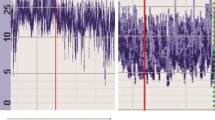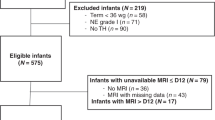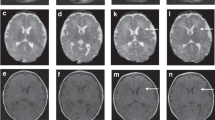Abstract
Objective:
Bayley-III scales are currently used to evaluate outcomes of term infants following hypothermia therapy, while all before reported outcomes in this population have used Bayley-II. Our objectives were to determine the incidence of abnormal neurodevelopmental outcomes using Bayley III and the predictive value of Magnetic resonance imaging (MRI) in infants who received systemic hypothermia.
Study Design:
We conducted a prospective cohort study of inborn infants who underwent hypothermia for moderate/severe neonatal encephalopathy from October 2005–November 2011.
Result:
Eighty newborns underwent hypothermia (incidence of 1/1000). Of the survivors, 89% had Bayley-III performed around 24 months of age. An abnormal outcome using Bayley-III <85 occurred in 50%, while Bayley III <70 occurred in 13%. MRI predicted Bayley III<85 with sensitivity of 73%, specificity of 84%, positive-predictive value of 84% and negative-predictive value of 74%.
Conclusion:
A Bayley-III 85 cutoff identifies a disability rate of 50%, and MRI was predictive of abnormal outcomes. Findings can be useful for counseling of families and planning of future studies using Bayley III.
This is a preview of subscription content, access via your institution
Access options
Subscribe to this journal
Receive 12 print issues and online access
$259.00 per year
only $21.58 per issue
Buy this article
- Purchase on Springer Link
- Instant access to full article PDF
Prices may be subject to local taxes which are calculated during checkout

Similar content being viewed by others
References
Levene ML, Kornberg J, Williams TH . The incidence and severity of post-asphyxial encephalopathy in full-term infants. Early Hum Dev 1985; 11 (1): 21–26.
Zhou WH, Cheng GQ, Shao XM, Liu XZ, Shan RB, Zhuang DY et al. Selective head cooling with mild systemic hypothermia after neonatal hypoxic-ischemic encephalopathy: a multicenter randomized controlled trial in China. J Pediatr 2010; 157 (3): 367–372. (e1–3).
Simbruner G, Mittal RA, Rohlmann F, Muche R . Systemic hypothermia after neonatal encephalopathy: outcomes of neo.nEURO.network RCT. Pediatrics 2010; 126 (4): e771–e778.
Shankaran S, Laptook AR, Ehrenkranz RA, Tyson JE, McDonald SA, Donovan EF et al. Whole-body hypothermia for neonates with hypoxic-ischemic encephalopathy. N Engl J Med 2005; 353 (15): 1574–1584.
Azzopardi D, Brocklehurst P, Edwards D, Halliday H, Levene M, Thoresen M et al. The TOBY Study. Whole body hypothermia for the treatment of perinatal asphyxial encephalopathy: a randomised controlled trial. BMC Pediatr 2008; 8: 17.
Jacobs SE, Morley CJ, Inder TE, Stewart MJ, Smith KR, McNamara PJ et al. Whole-body hypothermia for term and near-term newborns with hypoxic-ischemic encephalopathy: a randomized controlled trial. Arch Pediatr Adolesc Med 2011; 165 (8): 692–700.
Gluckman PD, Wyatt JS, Azzopardi D, Ballard R, Edwards AD, Ferriero DM et al. Selective head cooling with mild systemic hypothermia after neonatal encephalopathy: multicentre randomised trial. Lancet 2005; 365 (9460): 663–670.
Cotten CM, Shankaran S . Hypothermia for hypoxic-ischemic encephalopathy. Expert Rev Obstet Gynecol 2010; 5 (2): 227–239.
Barks JDE . Technical aspects of starting a neonatal cooling program. Clin Perinatol 2008; 35 (4): 765–775.
Barkovich AJ, Hajnal BL, Vigneron D, Sola A, Partridge JC, Allen F et al. Prediction of neuromotor outcome in perinatal asphyxia: evaluation of MR scoring systems. AJNR Am J Neuroradiol 1998; 19 (1): 143–149.
Higgins RD, Raju T, Edwards AD, Azzopardi DV, Bose CL, Clark RH et al. Hypothermia and other treatment options for neonatal encephalopathy: an executive summary of the Eunice Kennedy Shriver NICHD workshop. J Pediatr 2011; 159 (5): 851–858.
2006. BsoidNSTHA. Bayley scales of infant and toddler development. 3rd ed. Harcourt Assessment 2006.
Sarnat HB, Sarnat MS . Neonatal encephalopathy following fetal distress. A clinical and electroencephalographic study. Arch Neurol 1976; 33 (10): 696–705.
Shankaran S, Barnes PD, Hintz SR, Laptook AR, Zaterka-Baxter KM, McDonald SA et al. Brain injury following trial of hypothermia for neonatal hypoxic-ischaemic encephalopathy. Arch Dis Child 2012;97: F398–F404.
Palisano R, Rosenbaum P, Walter S, Russell D, Wood E, Galuppi B . Development and reliability of a system to classify gross motor function in children with cerebral palsy. Dev Med Child Neurol 1997; 39 (4): 214–223.
Palisano RJ, Hanna SE, Rosenbaum PL, Russell DJ, Walter SD, Wood EP et al. Validation of a model of gross motor function for children with cerebral palsy. Phys Ther 2000; 80 (10): 974–985.
Jary S, Whitelaw A, Walloe L, Thoresen M . Comparison of Bayley-2 and Bayley-3 scores at 18 months in term infants following neonatal encephalopathy and therapeutic hypothermia. Dev Med Child Neurol 2013; 55: 1053–1059.
Vohr BR, Stephens BE, Higgins RD, Bann CM, Hintz SR, Das A et al. Are outcomes of extremely preterm infants improving? Impact of Bayley assessment on outcomes. J Pediatr 2012; 161 (2): 222–228. (e3).
Moore T, Johnson S, Haider S, Hennessy E, Marlow N . Relationship between test scores using the second and third editions of the Bayley Scales in extremely preterm children. J Pediatr. 2012; 160 (4): 553–558.
Lowe JR, Erickson SJ, Schrader R, Duncan AF . Comparison of the Bayley II Mental Developmental Index and the Bayley III Cognitive Scale: are we measuring the same thing? Acta Paediatr 2012; 101 (2): e55–e58.
Acton BV, Biggs WS, Creighton DE, Penner KA, Switzer HN, Thomas JH et al. Overestimating neurodevelopment using the Bayley-III after early complex cardiac surgery. Pediatrics 2011; 128 (4): e794–e800.
Rutherford MA, Counsell SJ, Cowan FM, Azzopardi D, Edwards D, Renowden S et al. Magnetic resonance imaging patterns of brain injury following hypothermia in neonates with hypoxic ischemic encephalopathy. Pediatric Res 2004; 55 (4): 583a–583aa.
Rutherford M, Srinivasan L, Dyet L, Ward P, Allsop J, Counsell S et al. Magnetic resonance imaging in perinatal brain injury: clinical presentation, lesions and outcome. Pediatr Radiol 2006; 36 (7): 582–592.
Rutherford M, Ramenghi LA, Edwards AD, Brocklehurst P, Halliday H, Levene M et al. Assessment of brain tissue injury after moderate hypothermia in neonates with hypoxic-ischaemic encephalopathy: a nested substudy of a randomised controlled trial. Lancet Neurol. 2010; 9 (1): 39–45.
Acknowledgements
Dr Chalak is supported by Grant K23HD069521-01A11 and Gerber Foundation grant.
Author information
Authors and Affiliations
Corresponding author
Ethics declarations
Competing interests
The authors declare no conflict of interest.
Rights and permissions
About this article
Cite this article
Chalak, L., DuPont, T., Sánchez, P. et al. Neurodevelopmental outcomes after hypothermia therapy in the era of Bayley-III. J Perinatol 34, 629–633 (2014). https://doi.org/10.1038/jp.2014.67
Received:
Revised:
Accepted:
Published:
Issue Date:
DOI: https://doi.org/10.1038/jp.2014.67
This article is cited by
-
How well does neonatal neuroimaging correlate with neurodevelopmental outcomes in infants with hypoxic-ischemic encephalopathy?
Pediatric Research (2023)
-
Mild hypoxic-ischemic encephalopathy (HIE): timing and pattern of MRI brain injury
Pediatric Research (2022)
-
Perspectives from the Society for Pediatric Research. Neonatal encephalopathy clinical trials: developing the future
Pediatric Research (2021)
-
Regional heterogeneity of cerebral hemodynamics in mild neonatal encephalopathy measured with multichannel near-infrared spectroscopy
Pediatric Research (2021)
-
Can diffusion tensor imaging predict cerebral palsy in term neonates with hypoxic ischemic encephalopathy?
Egyptian Journal of Radiology and Nuclear Medicine (2019)



